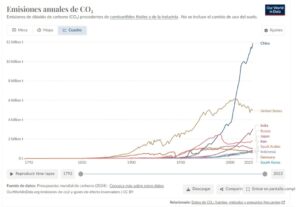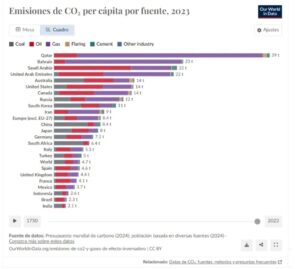Global CO2 emissions from fossil origin reached 37.4 billion tons in 2024, 0.8% higher than in 2023. This is the main conclusion of the Global Carbon Budget report, highlighted on the occasion of the World Day for Reducing CO2 Emissions, celebrated today.
Beyond the absolute data, where China remains at the forefront, it is important to review the per capita emissions ranking, as this data defines the impact of societies’ lifestyles on the environment and can make people reflect on their consumption habits. This is particularly relevant when countries with much fewer inhabitants than China have a significant per capita carbon footprint.
Today marks the World Day for Reducing CO2 Emissions, an environmental commemoration sponsored by the United Nations (UN) to raise awareness and encourage people worldwide to contribute to environmental and planetary care by reducing their carbon footprint.
The awareness of the need to reduce global CO2 emissions has been on scientists’ radar for over 100 years. In 1896, a Swedish scientist named Svante Arrhenius first predicted that changes in carbon dioxide levels in the atmosphere could potentially alter the Earth’s surface temperature through the greenhouse effect.
When the Kyoto Protocol was signed in 1997, this plan marked a step in the right direction towards reducing emissions of greenhouse gases from industrialized countries. However, it was not enough to reverse the trend. The Paris Agreement of 2015 legally committed 196 different countries to limit global warming by reducing greenhouse gas emissions to achieve a climate-neutral planet by the mid-21st century.
Carbon, in Figures
The Global Carbon Budget report indicates that in 2024 emissions from various fossil fuels increased: coal (0.2%), oil (0.9%), and gas (2.4%), contributing 41%, 32%, and 21% to global CO2 emissions from fossil origin, respectively.
By countries, emissions from China (32% of the global total) increased by 0.2%; emissions from the United States (13% of the global total) decreased by 0.6%; emissions from India (8% of the global total) increased by 4.6%; and emissions from the European Union (7% of the global total) decreased by 3.8%. Overall, emissions in the rest of the world (38% of the total) increased by 1.1%.
Total Annual Emissions vs Per Capita Emissions
It comes as no surprise that in the top 10 annual CO2 emissions, China (with over 11.9 billion tons -Gt-) leads a ranking followed by the United States (4.911 Gt), India (3.062 Gt), Russia (1.815 Gt), Japan (988 Gt), Iran (817 Gt), Saudi Arabia (736 Gt), Indonesia (733 Gt), Germany (596 Gt), and South Korea (577 Gt).
 Annual CO2 emissions[/caption>
Annual CO2 emissions[/caption>
Even more telling is the per capita emissions chart, a data point that defines the impact of societies’ lifestyles on the environment and can make people reflect on their consumption habits, especially when countries with much fewer inhabitants than China have a higher carbon footprint per capita.
In this ranking, we see how petrostates and Gulf countries like Qatar, Bahrain, Saudi Arabia, and the United Arab Emirates top the per capita emissions list, with 39 tons (t), 23 t, 22 t, and 22 t, respectively. Figures that, on the other hand, were expected in economies based on oil and gas extraction which less than a century ago were fishing villages.
But it is here where we start to see more striking figures:
Citizens of Australia (14 t), the United States (14 t), Canada (14 t), Russia (12 t), South Korea (11 t), Iran (9 t), and the average EU inhabitant (8.4 t) have a carbon footprint equal to or higher than the average Chinese (8.4 t).
 Per capita CO2 emissions by source 2023[/caption>
Per capita CO2 emissions by source 2023[/caption>
Evidently, China’s per capita emission figures reflect a country of almost 1.5 billion people, so they are more evenly distributed. But the most important environmental consideration is the cost of the Western way of life which, being much less populated societies, has a greater environmental impact per capita.
A Day for Reflection
The International Day for Reducing CO2 Emissions aims to raise awareness of this fact and encourage people worldwide to contribute to environmental and planetary care by reducing their carbon footprint. The entire society is invited to adopt new sustainable habits and consider ways to reduce our negative impact on Earth.
One of the most controllable contributors to CO2 emissions is the use of personal vehicles, especially if they are older models that are not environmentally friendly, so this day encourages considering alternative ways to commute to work, travel, or go shopping. These changes may require some extra time or additional planning, but it is worth it for the good of the planet.
Another way to contribute is to opt for renewable energies over fossil fuels. In fact, solar energy generated 11% of the EU’s electricity in 2024, surpassing coal for the first time, which fell below 10%, while wind (17%) produced more electricity than gas (16%) for the second consecutive year. These are the conclusions of the ‘European Electricity Review’, an analysis published by the expert group Ember, attributing to Spain the highest solar growth in the EU, as solar energy provided 21% of national electricity in 2024, up from

